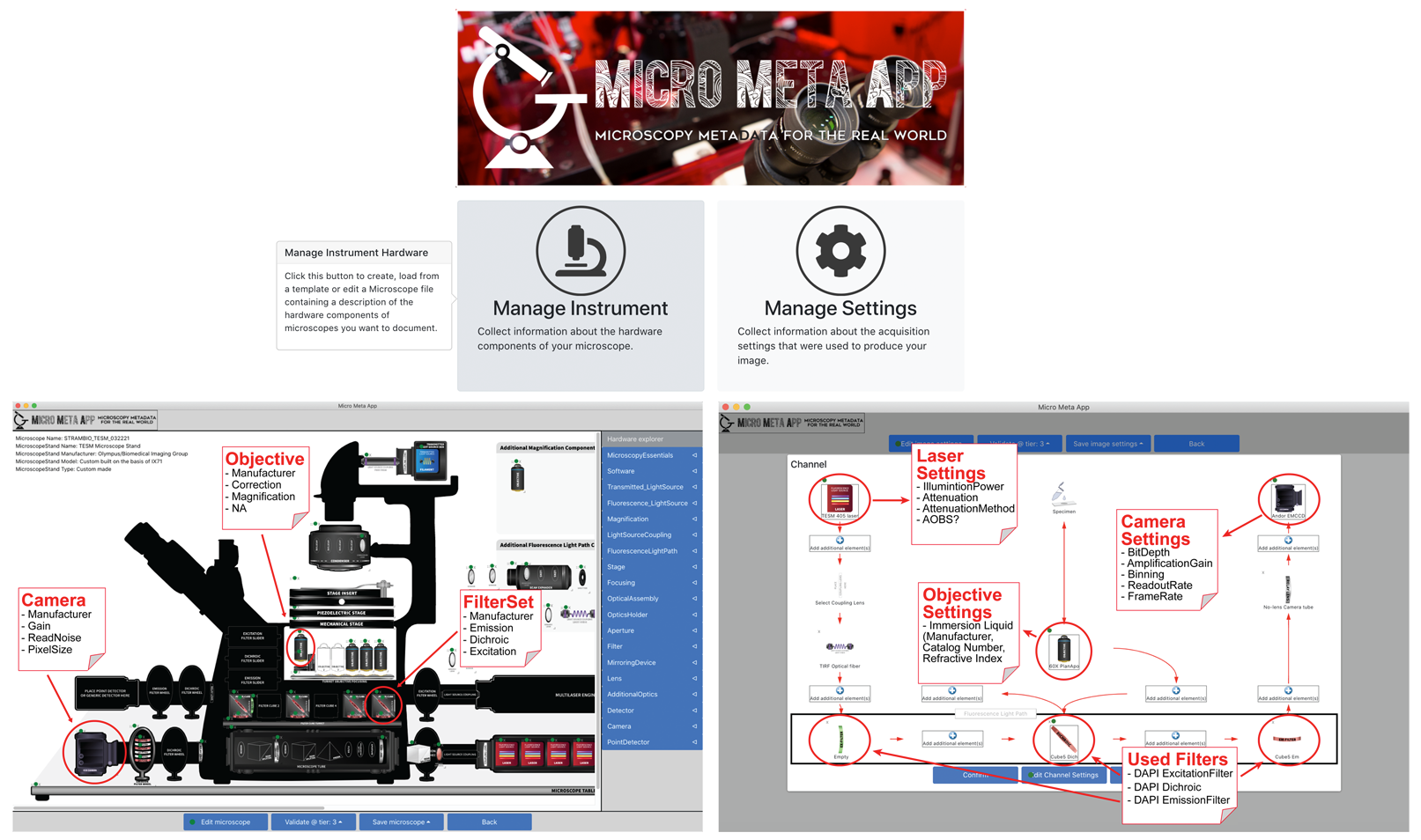Micro Meta App
Microscopy Metadata for the real world!
Micro Meta App is an open, easy to use, and powerful software platform that provides an intuitive visual guide to capture and manage Microscopy Metadata on the basis of the NBO-Q revision of the OME data model.
Micro-Meta App was developed as part of a global community initiative that led to multiple publications featured on a recent Nature Methods FOCUS ISSUE dedicated to Reporting and reproducibility in microscopy.
Learn More For more details on Micro-Meta App, consult our recent Nature Methods and BioRxiv.org publications!.
Important! In order to get started please use the following resources:
- Protocols.io Getting Started with the Micro-Meta App tutorial
- ReadTheDocs step-by-step instructions and
- Video tutorials
- Example JSON files
Note! If you intend to use Micro-Meta App on MacOS you might encounter difficulties un-zipping and launching the MacOS Zip. To address these issues please follow the instructions specified in this VIDEO
What is Micro-Meta App?

With Micro-Meta App you can:
1) Use Manage Instrument to document the hardware specifications of transmitted light, epifluorescence, structured-light and TIRF light microscopes based on the 4DN-BINA-OME Microscopy Metadata model.
2) Use Manage Settings to document the acquisition settings that were used to collect a specific image dataset. Here, the user extracts metadata available in the image header and in previously created Microscope.JSON files, enters missing information and produces a JSON file summarizing the conditions that were used for a specific acquisiton session.
Availability
The latest stable beta release is available as follows:
Application
Source code
- Javascript React implementation is available here
- Javascript Electron-wrapped implementation is available here
- Prototype OMERO plugin is available here
Major changes
- Updated data model including several new hardware components descrbed in the Core and Basic extension of the v2.00 of the 4DN-BINA-OME Microscopy Metadata model.
- Manage Settings component of the application to import image metadata from file headers using Bio-Formats.
- Improved GUI usability
- Several bug fixes (link)
Important! It is not recommended to mix different versions of Micro Meta App for working on Microcope or Settings files. If you started a project using in a previous version of the App please first save your file with the latest version and then proceed with collecting image acquisiton settings.
Important! If you started your project with an alpha version of the app please let us know and we will help you with the transition.
Example datasets
AVAILABLE EXAMPLE FILES A set of publicly available example JSON files that were generated using Micro-Meta App to document microscopy experiments from 16 different individual core facilities and videos to torials to get started are available:here from Zenodo.org.
Want to learn more?
For a thorought description of the 4DN-BINA-OME (NBO) Microscopy Metadata Specifications on which Micro-Meta App is based, consult our recent publications on Nature Methods and BioRxiv.org.
If you are a newby and you want to learn more about the importance of metadata and quality control to ensure full reproducibility, quality and scientific value in light microscopy, please take a look at our recently posted overview manuscript entitled “A perspective on Microscopy Metadata: data provenance and quality control”, which is available on ArXiv.org here.
Future directions!
Stay tuned for upcoming changes/improvements:
- Full implementatino of the Confocal/Advanced extension of the v2.01 of the 4DN-BINA-OME Microscopy Metadata model, which will allow to document Confocal and other Super-Resolution Miscoroscppy experiments.
- More intuitive GUI
- Initial integration of the of the Calibration/Performance extension of the v2.01 of the 4DN-BINA-OME Microscopy Metadata model, which will allow to document Intensity Calibration, Optical Calibratin and Mechanical Calibration.
- Automated Material and Methods writing through integration with MethodsJ2
- Facilitated import of vendor information and a better integration with the OMERO server. Stay tuned!
Other news!
June 2021: Micro-Meta App workshops featured at the 2021 ELMI Meeting
A series of three workshopson the use of Micro-Meta App were presented at the 2021 ELMI Meeting!
June 2021: Micro-Meta App flash-talk and demo presented at the 2021 OME Community Meeting
A flash-talk and a live-demo on the use of Micro-Meta App were presented at the 2021 OME Community Meeting!
June 2020: Micro Meta App featured on Medium!
A Chan Zuckerberg Initiative Medium article featuring the work of Caterina Strambio De Castillia and developemnt of Micro Meta App is available (here)!
May 2020: Micro Meta App presented at the OME Community Forum!
The talk entitled “Adaptable Community Standards and Intuitive Metadata Collection Tools for Quantitative Microscopy” in which Caterina Strambio De Castillia presented the Micro Meta App at the 2020 OME Community Meeting is available here.
Credits!
Important! Cite Micro Meta App as described here if you use it in your work!
Micro Meta App is produced at the University of Massachusetts Medical School.
The software is developed in collaboration with the 4D Nucleome (4DN) Data Integration and Coordination Center, as part of research projects funded by the NIH funded 4DN program.